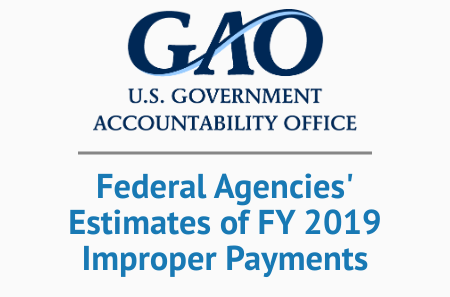
24 Jun MEDICAID IMPROPER PAYMENTS IN 2019
Improper payments in the Medicaid universe are payments full or partial claims payments paid in error or payments made to the wrong party. Improper payments have been a major problem for Medicaid in recent years and have cost the program’s valuable resources. Across all government programs, improper payments have been estimated to total nearly $1.7 trillion between 2003 and 2019. In March of this year, the GAO released its latest report, GAO-20-344, which estimated improper payments in federal agencies for FY 2019. The report specifies that federal agencies estimated improper payments amounted to a staggering $175 billion in 2019. The bulk of the improper payments came from three programs: Medicaid, Medicare, and the Earned Income Tax Credit (EITC). Medicaid had a 14.9% improper payment rate, up nearly 5.1% from 2018 and accounted for 32.8% or $57.4 billion of the $175 billion in government improper payments. Unfortunately, understanding these payments and their impact continues to be a challenge due to incomplete, unreliable, and understated estimates from agencies. In addition, agencies are not complying with reporting and additional requirements from the Improper Payments Elimination and Recovery Act of 2010 (IPERA). For example, eight out of fourteen agencies failed to publish and meet targets for reducing improper payments in 2019.
From 2018 to 2019, Medicaid’s improper payment rate increased by 5.1%.
According to the Department of Health and Human Services (HHS), the five-point jump in payments made in error was due in part to the department’s reintegration of the Payment Error Rate Measurement (PERM). In the prior four years, HHS did not estimate improper payments related to eligibility and they also used a proxy estimate that was last reported in 2014. Additionally, HHS was only able to estimate eligibility determination related improper payments for 17 states since the majority haven’t been measured since PERM was reintegrated. In the HHS FY 2019 financial report, the department cited that many of Medicaid’s improper payments stemmed from states not complying with provider screening and enrollment requirements. Furthermore, eligibility errors identified by PERM were a result of insufficient documentation to confirm eligibility or noncompliance with the requirements for redetermining eligibility.
Improper payments are taking valuable resources away from Medicaid and other government programs. These payments are reported as a monetary loss and they could have possibly been avoided or recovered. While reporting improper payments is helpful in understanding how prevalent they are, it does nothing to mitigate them. This must be addressed, especially in a time where unemployment has skyrocketed due to the Coronavirus pandemic. Millions of Americans are turning to the Medicaid program and every dollar counts.
